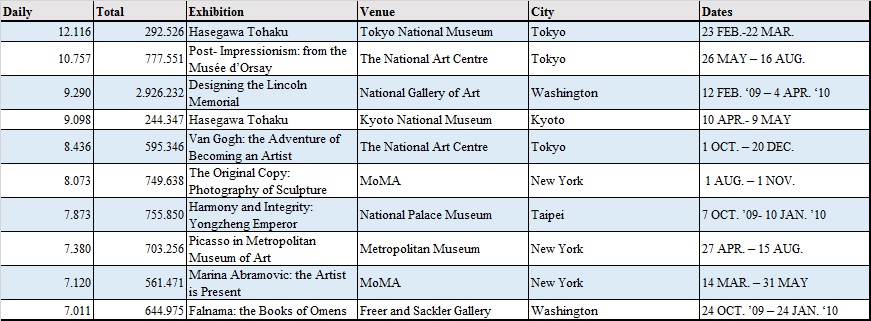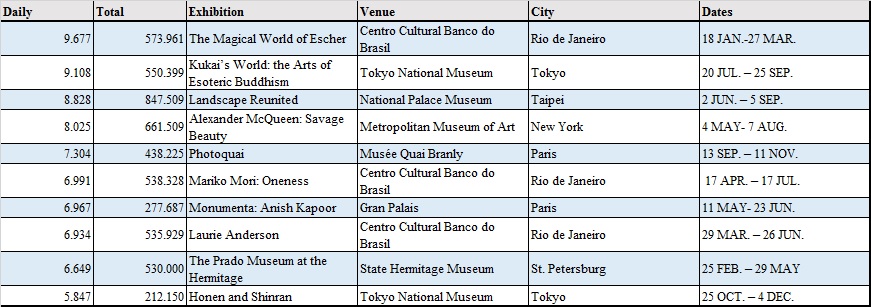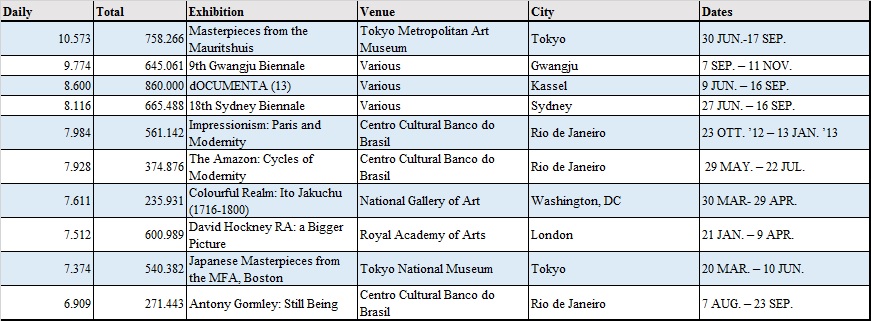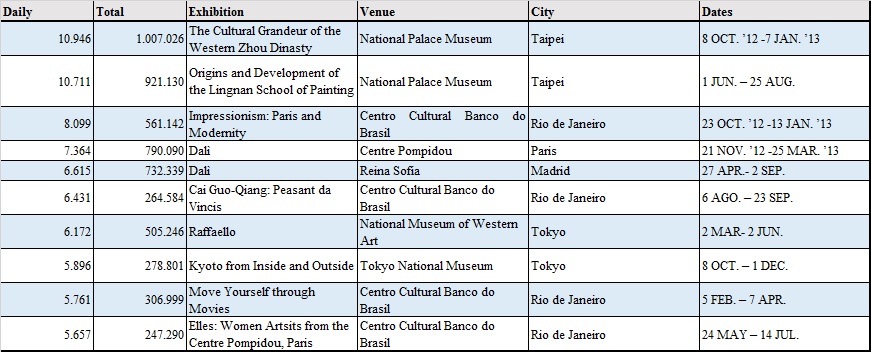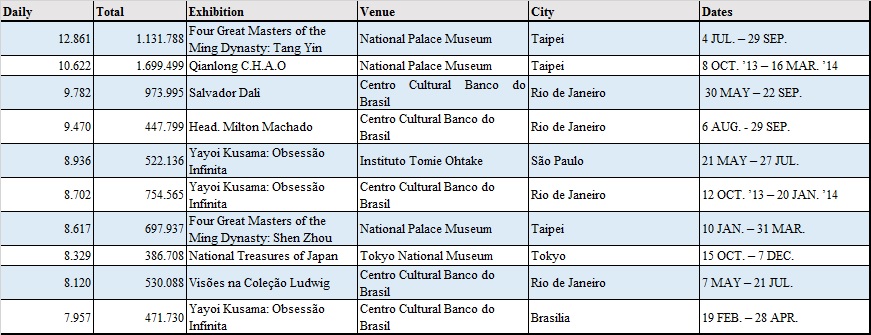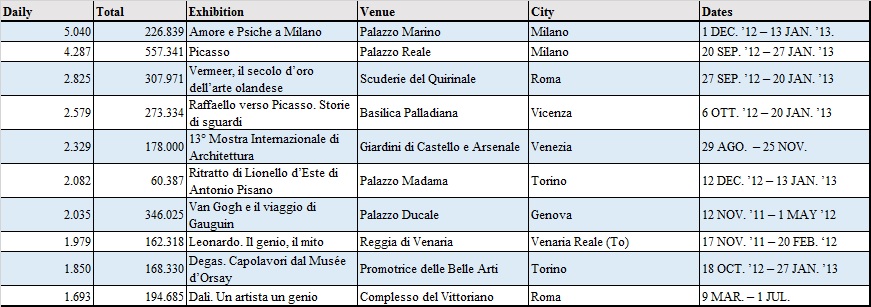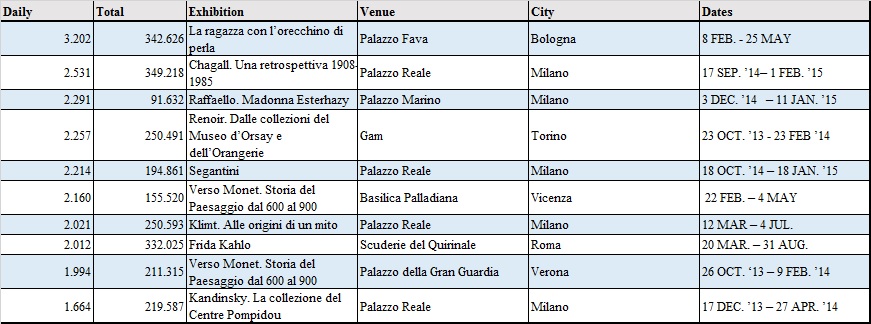Introduction
Exhibitions are a central component of the contemporary art system, as one of the favourite tools for cultural distribution, attraction of public and visibility of cultural organisations. Important instruments for the communication of scientific results and new cultural views, they have become an irreplaceable element for institutions like museums, which have strengthened the practice of exhibitions to promote and enhance their cultural offer.
At the same time, in the continuous quantitative and commercial development of the art system, museums have begun to resort to exhibitions in order to attract a larger public, and exhibitions have been affected by marketing techniques [1]. The growth of “blockbuster” exhibitions – popular and often low-quality events – is consistent with the measurement of cultural success in terms of “figures” [2].
The most visited exhibitions, as well as the most visited museums, represent cases of brilliant success that involve in a challenge old and developing cultural contexts, giving the possibility, to institutions and entire cities, of national and international prominence. Since exhibitions have become an increasingly important element of the cultural industry, in several cases a growth in the number of these events has been observed. If the escalation of the art festivals and Biennials is a worldwide phenomenon [3] , in Italy the amount of the exhibitions has exponentially increased in the last ten years, producing a trend –observed in France and Germany as well [4] – that has been defined as a real “mania of exhibitions” [5].
In order to understand the development of exhibitions as one of the major phenomena of the contemporary art system, an analysis of the most visited exhibitions between 2010 and 2014 was carried out. The study observed the global dimension of the trend and then focused on the specific case of Italy, a country where, as just said, the development of the exhibitions, in the last years, appears to be particularly significant.
Methodology
The study analysed the top ten of the most visited exhibitions in the years 2010-2014, at global level and in Italy, according to the daily number of exhibitions visitors. Data were extracted from the lists of the most visited exhibitions that are annually published by Il Giornale dell’Arte, in collaboration with The Art Newspaper [6]. The Italian journal was preferred as a source in order to adopt a uniform tool for the investigation of the global and of the Italian situation.
The study aimed to understand the mechanisms of attraction of public according to three different criteria: institutions, organizing and hosting the exhibitions; themes of the exhibitions; circulation of the exhibitions, at international and national level.
The analysis of the institutions considered two different elements: the typology of institution – “Museum” or “Exhibition Space” and “Public” or “Private” organization – and the geographic distribution of the institutions – at global level and in Italy. In this classification, the term “museum” refers to institutions with a permanent collection, as opposed to “exhibition space”. “Public” or “private” denotes the property of the institution. The geographical distribution analysed the presence of the institutions hosting top-ten exhibitions in each continent and, in the case of Italy, in each Region.
The analysis of the themes of the exhibitions was based on a main distinction of the events in two categories: “Exhibitions” and “Biennials”, where the term “Biennials” refers to recurrent large-scale international contemporary art exhibitions. In a second moment, an investigation of the topics of the exhibitions (including the Biennials) was carried out, according to a distribution of the exhibitions in thirteen main categories: Archaeology (artistic production before 476 A.D.), Medieval Art (5th-14th century), Modern Art (15th -20th century), Contemporary Art (20th century-), Traditional Chinese Art, Traditional Japanese Art, Architecture, Photography, Fashion/Design, Ethnography/Anthropology, History, Other [7]. The categories “Archaeology”, “Medieval Art” and “Modern Art” refer to the Western artistic production, whereas the classification shows a greater simplification in the analysis of the Eastern artistic production (traditional vs. contemporary). Despite the Western focus, which was functional to the examination of the Italian situation, after a general classification, a more detailed analysis of the topics was carried out for both the Western and the Eastern context.
The international circulation describes the movement, at global and national level, of the exhibitions organized and hosted in more than one institution, or presented only in one venue but organized in collaboration with almost another institution.
For each category, the study took into account the hierarchy according to the position in the list and the percentage of the events referring to each year and to the overall five years. Data did not consider the exhibitions presented in museums that have one ticket for the entire institution and cannot provide individual attendance for temporary exhibitions. They constitute a peculiar typology that was preferred not to include in the study, which focused on the events the public certainly wanted to attend.
The analysis is introduced by the lists of the most visited exhibitions in the years 2010-2014, extracted from Il Giornale dell’Arte [8].
Table 1: Most Visited Exhibition, 2010
Table 2: Most Visited Exhibition, 2011
Table 3: Most Visited Exhibitions 2012
Table 4: Most Visited Exhibitions 2013
Table 5: Most Visited Exhibitions 2014
Table 6: Italy, Most Visited Exhibitions 2010
Table 7: Italy, Most Visited Exhibitions 2011
Table 8: Italy, Most Visited Exhibitions 2012
Table 9: Italy, Most Visited Exhibitions, 2013
Table 10: Italy, Most Visited Exhibitions 2014
Institutions
The analysis of the institutions hosting the most visited exhibitions in the years 2010-2014 will start with an examination of their typology and then will consider their geographic distribution.
International Context
As for the typology of institution, at international level museums are prevalent, considering both the positions in the lists and the percentage of the institutions. Events presented in museums are always in the top three of the most visited worldwide exhibitions, with the only exception of 2012, when three Biennials –Gwanju Biennale of Contemporary Art, Kassel dOCUMENTA and Sydney Biennale – presented in exhibition spaces, are at the first positions of the list. The percentage of the most visited exhibitions according to the typology of hosting institutions shows a prevalence of museums, considering both each year and the overall five years (90%).
The percentage of the exhibitions according to the public or private typology of institution shows a balanced division between public (52%) and private (48%) organizers in the five years. Public institutions are also at the first positions of the ranks, with the only exception of the CCBB in Rio de Janeiro [9], at the very first positions in 2011 and 2013, and the Foundations for the Art Biennals of Gwanju, Kassel and Sydney, which appear at the second, third and fourth position, respectively, in 2012.
Data regarding the typologies of institutions – museums/exhibition centres and public/private organisations– can be clarified looking closer at these institutions. In the overall five years, the institution that hosted the largest number of top-ten exhibitions is the Centro Cultural Banco do Brasil (CCBB) in Rio de Janeiro (29% of the overall exhibits). It is followed by the National Palace Museum of Taipei (14%) and the National Museum of Tokyo (10%). Then, it is possible to find, at the same percentage of hosted exhibitions (4%), the National Art Centre of Tokyo, the National Gallery of Art in Washington, The Museum of Modern Art and the Metropolitan Museum of Art in New York. Besides the exhibitions spaces hosting the 2012 Biennials, already mentioned, the Grand Palais in Paris and the Instituto Tomie Ohtake in São Paulo are the only other exhibition centres. In addition to the Foundations for the Biennials, included in the 2012 rank, the CCBB, the Instituto Tomie Ohtake, the Metropolitan Museum of Art and the MoMA are the only private institutions presenting top-ten exhibitions in the years 2010-2014.
The CCBB in Rio de Janeiro, the National Palace Museum of Taipei and the National Museum of Tokyo not only have a large percentage of top-ten exhibitions, but are also at the very first positions of the lists for most of the five years. The institutions hosting the most popular exhibitions were mostly included in the top 100 of the most visited museums in the world, according to ranks of The Art Newspaper, in the years 2010-2014 [10]. In particular, the rise of the Taipei National Palace Museum and of the CCBB of Rio de Janeiro in the ranks of the most visited worldwide museums corresponds to their progressively more significant role as exhibitions organizers.
The analysis of the institutions can also explain the geographic distribution of the most visited worldwide exhibitions between 2010 and 2014. In the overall five years, Asia is the continent with the highest number of popular exhibitions, followed by South America, North America and Europe. Oceania hosted only the Biennale of Sydney in 2012. This distribution is actually the reflex of a high-centralized reality. Few countries represent the mentioned continents and, in each country, few cities. Asia is represented by Japan, Taiwan and South Korea; South America by Brazil; North America is represented by the United States and Europe by France, followed by Spain, Russia, Germany and Great Britain. As for the cities, we observe an even more centralized situation. Rio de Janeiro shows the clear predominance of hosted exhibitions (28% of the overall exhibits), followed by Tokyo (20%), Taipei (14%), New York (8%), Washington and Paris (6%).
In conclusion, few great institutions succeeded in the organization of exhibitions at global level between 2010 and 2014. They were mainly museums of global importance, with a predominance of the Centro Cultural Banco do Brasil in Rio de Janeiro and of the National Museums of Taipei and Tokyo. Apart from the Biennials that appear in the 2012 rank, the main exhibition spaces were the Grand Palais and the Instituto Tomie Ohtake in São Paulo, and the main private institutions were the CCBB in Rio de Janeiro and the American museums, that is, the MoMA and the Metropolitan Museum of Art.
Italy
The analysis of the Italian context shows a slightly different situation. The institutions hosting the most visited exhibitions are mainly exhibition centres. Few exceptions are represented by Museo della Fondazione Roma (Edward Hopper, 2010), Musei Capitolini (Tiffany & Gallé, 2013) and Gam Torino (Renoir. Dal Museo d’Orsay e dell’Orangerie, 2014).
The analysis of the institutions according to their public or private typology shows a large majority of public organizations [11], both for each year and in the overall five years (74%). Some exceptions are represented by Palazzo Zabarella, belonging to Fondazione Bano; Fondazione Promotrice di Belle Arti and Officine Grandi Riparazioni, in Torino; Casa dei Carraresi, belonging to Fondazione Cassamarca. A significant role is played by public-private Foundations: the Foundation for the Venice Biennale, Fondazione Reggia di Venaria Reale, Fondazione Palazzo Strozzi and Fondazione Torino Musei [12].
The venues with the highest percentage of hosted exhibitions, in the overall five years, are Palazzo Reale, in Milan; Scuderie del Quirinale, in Rome; Arsenale and Giardini, in Venice; Palazzo delle Esposizioni and Complesso del Vittoriano, in Rome; Palazzo Marino, in Milan. These institutions drew the 56% of the most visited Italian exhibitions, whereas the resulting 44% was presented in institutions that do not appear regularly in the top-ten of the Italian exhibitions between 2010 and 2014.
Such as in the international context, also in Italy the most popular exhibitions were concentrated in few areas. They were mainly organized in the Regions of the North and of the Centre of Italy, whereas the South hosted only one event entering the top-ten of the most visited exhibitions (Ritorno al Barocco. Caravaggio-Vanvitelli, 2010). The Region with the highest number of popular exhibitions is Lazio, followed by Lombardia, Veneto, and Piemonte. The distribution according to the cities hosting the institutions that organized the most visited exhibitions shows an even more centralized situation. Lazio is actually represented by the only city of Rome, which hosted the highest number of popular exhibitions (29% of the overall exhibitions), followed by Milan (24%), Venice and Torino (9%). Rimini presented two popular exhibitions in 2010 and 2011, Vicenza in 2012 and 2014. It is worth highlighting that the geographic areas hosting the most popular exhibitions in the years 2010-2014 – North and Centre – coincide with the ones that, in the years 2009-2012, organized the highest number of exhibitions in Italy [13]. In the same way, Lombardia and Lazio were the Regions presenting the largest number of exhibitions [14] and the most popular ones.
In Italy, between 2010 and 2014, exhibitions having a separate ticket that were successful in terms of number of visitors were mainly organized in public exhibition centres. As for the typology of organizations, the most significant exception is the Foundation for the Venice Biennale, organizing the Biennale of Contemporary Art and the Biennale of Architecture. The geographic distribution shows a clear predominance of the Regions of the North and of the Centre of Italy, which are actually represented by few cities: Rome, Milan, Venice and Torino.
Themes
The analysis of the themes of the exhibitions will consider two main elements. First of all, the events will be analysed according to a main distinction in Exhibitions and Biennials. In a second moment, an investigation of the themes will be carried out, starting from a general classification and proceeding to a more detailed study.
International Context
Given their periodical organization, Biennials are obviously less numerous than exhibitions. Nevertheless, they entered the top-ten of the most visited worldwide exhibitions in 2011 and 2012. In particular, in 2012 it is possible to find three Biennials of contemporary art: the historical Kassel dOCUMENTA, the Biennal of Sydney and the Gwanju Biennal. As aforementioned, these events also appear at the second, third and fourth positions of the list of the most popular exhibitions of the year.
The analysis of the percentage of exhibitions according to the topics – organized following the previously described classification [15] – shows a clear predominance of Contemporary Art (44% of the overall exhibitions in the five years), followed by Modern Art and Traditional Japanese Art (16%). At an inferior percentage, it is possible to find Traditional Chinese Art (8%), and further Photography and History (4%), followed by Ethnography/Anthropology and Fashion (2%). The analysis of the distribution of the themes in the different years shows that Contemporary Art has become progressively more important starting from 2011, Photography was present until 2011, when also Traditional Chinese Art appeared in the ranks.
At a more detailed level, exhibitions of contemporary art show a preference for the artistic production “after the 1950s”, which result to be in a higher percentage than the artistic production “before the 1950s”. This latter is mainly represented by events related to popular artists of the first half of the 20th century: Picasso, Dali, Kandinsky, Escher. On the other hand, the exhibitions on the artistic production “after the 1950s” mainly concern alive artists of global resonance – David Hockney, Antony Glomrey, Anish Kapoor, Laurie Anderson, Marina Abramovi?. Not-western artists – Cai Quo-Qiang, Mariko Mori, Yaoyoi Kusama, Milton Machado – reached a progressively more significant role in the five years.
Exhibitions of modern art indicate a preference for the 19th century artistic production, which is represented by artistic movements – namely Impressionism and Post-Impressionism – by great artists – Van Gogh – and by artistic expressions of national value (Designing the Lincoln Memorial, 2010). Exhibitions on 16th and 17th -century art come just after.
Japanese art is mainly represented by exhibitions of treasures of national and religious value and by exhibitions of traditional painting. This fact seems to indicate a peculiar interest for topics of religious and national significance that the Japanese exhibits share with the Chinese shows, mainly concerning the art and the history of the country.
To summarize, visitors were mainly attracted by exhibitions related to a strictly contemporary artistic production and to the artistic expressions of “modernity”: from one hand, the Avant-gardes and the other artistic expressions of the beginning of the 20th century; from the other, Impressionism and the big artists of the late 19th century. The successful exhibitions organized in the Eastern world seem to be part of a process of national and religious recognition and self-identification.
Italy
In Italy, the analysis of the typology of the events shows the constant inclusion of the Venice Biennali – Art and Architecture – in the top-ten of the most popular exhibitions, with the only exception of 2014.
The analysis of the exhibitions themes highlights some peculiarities. Modern Art clearly dominates on the other topics, with 34 top-ten exhibitions in five years (68% of the overall exhibitions). It is followed by Contemporary Art, with 11 exhibitions (22%) – 2 represented by the Venice Biennale – and Architecture (4%) – in turn represented by the Venice Biennale. The topics of the other successful exhibitions concern History, Photography and Ethnography.
An analysis of the topics of the exhibitions of modern art shows the predominance of the 19th-century artistic production, which is mainly represented by great artistic movements and personalities – Impressionism, Art Nouveau, Van Gogh, Klimt. It is followed by 15th-18th century art, which is embodied by the Italian and European artistic production and its big representatives: Raffaello, Botticelli, Leonardo, Tiziano, Lotto, Caravaggio, Vermeer. A significant position also belongs to the exhibitions gathering different periods, artists or artistic expressions, which were hosted in Rimini, Vicenza and Verona (Da Rembrandt a Gauguin a Picasso, 2010; Verso Monet. Storia del Paesaggio dal 600 al 900, 2014).
The exhibitions of contemporary art show a preference for the artistic production “before the 1950s”, with still a predominance of popular artists – Picasso, Dali, Kandinsky, Frida Kahlo, Hopper, Calder. The strictly contemporary production is dominated by the Venice Biennale, which, in its two editions, appears at the first positions of the top-ten Italian exhibitions.
As it has been observed, in Italy the numerical development of the exhibitions, in the last years, has mainly affected the events dedicated to contemporary art, which represent the largest part of the exhibitions organized in the country [16]. On the other hand, the analysis of the themes of the most popular Italian exhibitions shows a preference for Modern Italian art and for the international artistic production of the 19th and the beginning of the 20th century. Indeed, the strictly contemporary artistic production is mainly represented by the Venice Biennials, which are always, with the only exception of 2014, among the most visited events in both the editions – Art and Architecture.
National and International Circulation
The national and international circulation takes into account the movement of the events that were presented in more than one institution, as well as the collaboration between institutions that cooperated in the organization of exhibitions.
International Context
At international level, it is possible to observe a quite high presence of exhibitions that were organized and hosted in two or more institutions, with 22 events in the years 2010-2014, and a significant growth in 2013 and 2014.
The highest percentage of this typology of exhibitions belongs to the Centro Cultural Banco do Brasil, which hosted events in the seats of Rio de Janeiro, São Paulo, and Brasilia: the exhibitions on Escher and Laurie Anderson in 2011; the exhibition on Antony Glomery in 2012; again in 2012 and in 2013, the exhibition on Impressionism, which was also organized in collaboration with the Musée d’Orsay; in 2014, the exhibitions on the Ludwig Collection and on Yayoi Kusama, which had an international circulation in Latin America (Instituto Tomie Othake in São Paulo, MALBA in Buenos Aires, Museum Tamayo in Mexico City). Indeed, the CCBB collaborated with national and international institutions, particularly in 2013, when we can observe partnerships with the Centro Cultural Correios in Rio de Janeiro (Cai Guo-Qiang), the Barbican Centre in London (Move Yourself through Movies) and the Centre Pompidou (Elles: Female Artists in the Collection of the Centre Pompidou, also presented at the Seattle Art Museum). In 2014, it is possible to highlight the cooperation with the Museo Nacional Centro de Arte Reina Sofia in Madrid, the Gala-Salvador Dalì Foundation in Girona and the Dalì Museum in San Petersburg for the exhibition Salvador Dalì (presented also at the Instituto Tomie Othake of São Paulo in 2015). The Centre Pompidou represents another institution hosting exhibitions with an international circulation. In addition to the collaboration with the CCBB, it is possible to notice a cooperation with the Museo Nacional Centro de Arte Reina Sofia in Madrid, in 2013, for the monographic exhibition on Dalì. Another cooperation is the one that can be highlighted between the National Museums of Tokyo (National Museum, National Art Centre) and the Kyoto National Museum (Hasegawa Tohaku, in 2010). Tokyo Museums also collaborated with international institutions, from the Musée d’Orsay (Post Impressionism, presented at the National Art Centre in 2010) to the Museum of Fine Arts of Boston (Japanese Masterpieces from the Museum of Fine Arts of Boston, presented at the National Museum in 2012) and Florence Museums (Raffaello, hosted in the National Museum of Western Art in 2013). As for the international cooperation, it is also possible to highlight the collaboration between the Hermitage Museum and the Museum of Prado for the exhibition The Prado in the Hermitage (2011), which was followed by the exhibition The Hermitage in the Prado (2012).
We can conclude that the circulation of the exhibitions shows important collaborations at national level, in Brazil between the different venues of the CCBB, and in Japan between the National Museums of Tokyo and Kyoto. As for the international circulation, a prominent position belongs to the Centre Pompidou, which collaborated with other museums of contemporary art of international importance. The topics of the exhibitions with an international circulation were mainly related to contemporary art, from the great masters of the first half of the 20th century (Dali, Kandinsky, Escher) to the strictly contemporary artistic production. The international collaboration was mainly related to modern art.
Italy
In Italy, the situation is quite different. In 2011 and 2012, it is not possible to find any popular exhibition with national or international circulation, whereas in 2010, 2013 and 2014 from one to 4 events of this typology entered the top ten of the most popular exhibitions.
In 2010, an exhibition with an international circulation was presented at Museo della Fondazione Roma (Edward Hopper, organized with the Whitney Museum of American Art, New York, and presented at Fondation de l’Hermitage, Losanna and Palazzo Reale, Milan).
In 2013, an exhibition with an international circulation was hosted in Palazzo delle Esposizioni, Roma (Sulla Via della Seta, which was also presented at the American Museum of Natural History, New York; The National Museum of Australia, Canberra; The National Museum of Natural Science, Taichung, Taiwan). As for the national circulation, in 2013 it is possible to notice a collaboration between Palazzo della Gran Guardia in Verona and Basilica Palladiana in Vicenza, for the exhibition Da Botticelli a Matisse; the two institutions collaborated again in 2014 for the exhibition Verso Monet. Storia del Paesaggio dal 600 al 900. In 2012 and 2013, exhibitions with an international organization were presented at Promotrice di Belle Arti, Torino (Degas, in collaboration with Musée d’Orsay, Paris), Palazzo Reale, Milan (Picasso, in collaboration with Musée Picasso, Paris) and Palazzo Ducale, Venice (Manet, in collaboration with the Musée d’Orsay)
In 2013, the most visited exhibition was organized at Palazzo Marino, Milan, in collaboration with the Vatican Museums (Raffaello, la Madonna di Foligno). In 2014, the most popular exhibition (La ragazza con l’orecchino di perla), was hosted in Palazzo Fava, Bologna, as part of a travelling exhibition that was organized by the Mauritshuis (the painting was also exhibited at the National Museum of Western Art, Tokyo; the High Museum, Atlanta; the de Young Museum, San Francisco; the Frick Collection, New York). Palazzo Reale collaborated with the Musées Royaux des Beaux-Arts, Brussels, for the exhibition on Chagall.
Other exhibitions with an international organization were presented again in Milan, at Palazzo Reale (Klimt. Alle origini di un mito, in collaboration with the Belvedere Museum, Vienna; Kandinsky. La collezione del Centre Pompidou, in collaboration with the Centre Pompidou, Paris), and Palazzo Marino (Raffaello. Madonna Esterhazy, in collaboration with the Museum of Fine Arts, Budapest). The exhibit on Frida Kalho at Scuderie del Quirinale was organized in collaboration with Palazzo Ducale in Genova, which presented the parallel exhibition Frida Kalho e Diego Rivera.
In Italy, the cooperation at international and at national level mainly concerned modern and contemporary art exhibitions. It involved different typologies of institutions, from small-size organizations to the exhibitions centres that were constantly among the most successful organizers in terms of attraction of public.
Conclusions
The analysis of the most popular exhibitions at global level and in Italy between 2010 and 2014 shows some significant elements of reflection.
The most successful events in terms of number of visitors were organized in the Eastern world, with a dominant position of Japan and Taiwan. Japan was also one of the states organizing the largest number of popular exhibitions in the considered five years. According to both the positions in the lists and the percentage of successful events, Brazil shows in turn a prominent position, confirming its important role of developing cultural reality [17]. Among the old cultural scenes, the United States kept a noticeable place, followed by France. These countries are actually represented by few cities of global visibility and by few institutions, which are mostly public museums in the Eastern world and private museums in the case of Brazil and the United States. It is worth mentioning the Centro Cultural Banco do Brasil in Rio de Janeiro, the National Museum and the National Art Centre in Tokyo, the Taipei National Palace, the MoMA and the Metropolitan Museum of Art in New York, the Centre Pompidou in Paris.
These institutions collaborated in the organization of successful exhibitions at international and national level. The strategies of cultural promotion and public attraction that were developed in Brazil and in Japan appear to be particularly significant, with a circulation of exhibitions among the different venues of the CCBB and collaborations between the National Museums of Tokyo and Kyoto.
Exhibitions on the artistic expressions of the 19th century and of the beginning of the 20th century attracted a large public, as well as the exhibitions of modern art. In Japan, exhibitions were dominated by the events dedicated to traditional Japanese art. A particular position belongs to the exhibitions of treasures of national and religious value, which in Taiwan and Japan attracted a huge amount of visitors.
In the five years, the average number of daily visitors, in reference to the top exhibitions, was around 11.200, with the lowest value in 2011. These figures are much higher than the average number of daily visitors of the Italian top exhibitions, which kept a stable value around 4.400.
The geographic distribution of the most successful exhibitions in Italy shows, such as for the global situation, the power of attraction of few cities and institutions. They are represented by some important exhibition centres of Milan, Rome and Venice: Palazzo Reale and Palazzo Marino, Palazzo delle Esposizioni and Scuderie del Quirinale, Giardini and Arsenale (these latter hosting the Venice Biennali).
These institutions collaborated at national and international level. A constant trend of the most popular Italian exhibitions, between 2010 and 2014, is the majority of the events dedicated to the artistic production of the 19th and beginning of the 20th century, followed by the events on the artistic production of the 15th -18th century. Another stable element is the presence of the Venice Biennali, of Art and Architecture, in the lists of the most successful exhibitions, with the significant exception of 2014. It is important to highlight that, although the daily number of visitors of the Venice Biennials was lower than the average of the worldwide top exhibitions, the total number of visitors could compete in the global framework.
In conclusion, the Italian and the global context, despite some common features, are mainly separated one from the other. According to the typology of data that were analysed, and discussing in terms of capability of attraction of public, Italian institutions organizing exhibitions with a specific ticket were just partially able to compete in the global framework, which was dominated by powerful developing cultural contexts and by the traditional strength of well-established global museums.
Quotes
[1] See H. Belting, A. Buddensieg, P. Weibel, The Global Contemporary and the Rise of New Art Worlds, The MIT Press, Cambridge, MA / London, England, 2013.
[2] On “blockbuster” exhibitions, see R. E. Spear, “Art History and the “Blockbuster” Exhibition”, The Art Bulletin, Vol. 68, No. 3 (September 1986), pp. 358-359; S. Freedberg, “On “Art History and the ‘Blockbuster’ Exhibition”, The Art Bulletin, Vol. 69, No. 2 (June 1987), pp. 295-298; S. Bagdali, Il museo come azienda. Management e organizzazione al servizio della cultura, Etas Libri, Perugia, 1998, pp. 103-105, J. Beck, “The End of Blockbuster Exhibitions?”, Source: Notes in the History of Art, Vol. 20, No. 3 (Spring 2001), pp. 1-4; D. Levi, “At what expense? And at what risk?” Qualche riflessione sulla legittimità delle mostre”, Il sonno della ragione genera mostre? Predella, Journal of Visual Arts, No. 16 (December 2005)
[3] See Belting and others, op. cit., pp. 257-258.
[4] See Effetto mostre. L’organizzazione delle mostre in Italia e all’estero, Atti della seduta allargata del Comitato tecnico scientifico per il Patrimonio Storico Artistico ed Antropologico (Roma, Complesso monumentale di San Michele a Ripa, Sala dello Stenditoio, 14 ottobre 2008), Edifir, Edizioni Firenze, Pisa, 2009, p. 167.
[5] See G. Guerzoni, “Mostramania. Fine di un’illusione?”, Il sonno della ragione genera mostre? Predella, Journal of Visual Arts, No. 16 (December 2005); E. Pellegrini, “Mostrare significa valorizzare?”, Il sonno della ragione genera mostre? Predella, Journal of Visual Arts, No. 16 (December 2005); Effetto mostre, cit; G. Guerzoni, Le mostre al tempo della crisi. Il sistema espositivo italiano negli anni 2009-2011, Biennale Internazionale dei Beni Culturali e Ambientali (Firenze 3-11 novembre 2012), Firenze, Fondazione Florens, 2012; G. Guerzoni, Le mostre al tempo della crisi. Il mercato italiano nel 2012, AMIEX (Torino, 11 marzo 2014), Fondazione di Venezia, 2014.
[6] The list of the most visited exhibitions, in the world and in Italy, is published by Il Giornale dell’Arte every April.
[7] The categories “Medieval Art” and “Modern Art” refers to a common periodization in use in the Western world. “Contemporary” refers to the overall artistic production of the 20th century and includes the 21th century artistic production, according to a periodization in use in Europe, whereas in the United States the same period is divided in “modern art” (from Post-Impressionism to the Second World War) and “contemporary art” (from the 1940s to present). See also F. Poli, Arte Contemporanea, le ricerche internazionali dalla fine degli anni ’50 a oggi, Milano, Mondadori Electa, 2009, pp. 7-9.
[8] he lists were extracted from Il Giornale dell’Arte, n. 308 (April 2011) for tables 1 and 6; n. 319 (April 2012) for tables 2 and 7; n. 330 (April 2013) for tables 3 and 8; n. 341 (April 2014) for tables 4 and 9; n. 352 (April 2015) for tables 5 and 10.
[9] The Centro Cultural Banco do Brasil is a private institution, since it belongs to the Banco do Brasil (Brazilian Bank) and it is not a direct property of the State. Anyway, Banco do Brasil is owned for the 76% by the Brazilian Government, which directly controls it. See www.bb.com.br, accessed December 10th, 2014.
[10] See The Art Newspaper, n. 223 (April 2011), n. 234 (April 2012), n. 245 (April 2013), n. 256 (April 2014), n.267 (April 2015).
[11] “Aziende speciali” (e.g. Palaexpo, managing Palazzo delle Esposizioni and Scuderie del Quirinale) are public bodies
[12] hey are qualified as legal private persons governed by the Civil Code, although they are mainly o partly managed by public institutions. See C. Prele, La fondazione. Evoluzione giuridica di un istituto alla ribalta, Torino, Fondazione Giovanni Agnelli, 2008; A. Angiuli, Le fondazioni culturali. Prospettive italiane ed europee, Genova, Brigati, 2009.
[13] Guerzoni, op. cit. 2012 and 2014a.
[14] Ibid.
[15] See “Methodology”
[16] Guerzoni, op. cit., 2011 and 2014a.
[17] See also Belting and others, cit.
References
“Exhibition & museum attendance figures 2010”, The Art Newspaper, n. 223 (April 2011), pp. 23-30.
“Exhibition & museum attendance figures 2011”, The Art Newspaper, n. 234 (April 2012), pp. 35-43.
“La classifica annuale delle mostre più visitate”, Il giornale dell’arte, n. 308 (April 2011), pp. 1, 12-24.
“La classifica annuale delle mostre più visitate”, Il giornale dell’arte, n. 319 (April 2012), pp. 1, 10-20.
“La classifica annuale delle mostre più visitate”, Il giornale dell’arte, n. 330 (April 2013), pp. 1, 40-44.
“Per il ventesimo anno la classifica annuale delle mostre più visitate”, Il giornale dell’arte, n. 341, (Aprile 2014), pp. 1, 10-20.
“Per il ventunesimo anno la classifica annuale delle mostre più visitate”, Il giornale dell’arte, n. 352, (Aprile 2015), pp. 33-38.
“Visitor Figures 2012”, The Art Newspaper, n. 245 (April 2013), pp. 15, 21-29.
“Visitor Figures 2013”, The Art Newspaper, n. 256 (April 2014), pp. 22-30.
“Visitor Figures 2014”, The Art Newspaper, n. 267 (April 2015), pp. 2, 8-15.
Angiuli, Alessandra. Le fondazioni culturali. Prospettive italiane ed europee. Genova, Brigati, 2009.
Bagdali, Silvia. Il museo come azienda. Management e organizzazione al servizio della cultura. Etas Libri, Perugia, 1998, pp. 103-105.
Beck, James. “The End of Blockbuster Exhibitions?”, Source: Notes in the History of Art, Vol. 20, No. 3 (Spring 2001), pp. 1-4.
Belting, Hans; Buddensieg, Andrea; Weibel, Peter. The Global Contemporary and the Rise of New Art Worlds. The MIT Press, Cambridge, MA / London, England, 2013.
Effetto mostre. L’organizzazione delle mostre in Italia e all’estero. Atti della seduta allargata del Comitato tecnico scientifico per il Patrimonio Storico Artistico ed Antropologico (Roma, Complesso monumentale di San Michele a Ripa, Sala dello Stenditoio, 14 ottobre 2008). Edifir, Edizioni Firenze, Pisa, 2009.
Freedberg, Sydney J. “On “Art History and the ‘Blockbuster’ Exhibition”, The Art Bulletin, Vol. 69, No. 2 (June 1987), pp. 295-298.
Guerzoni, Guido. “Mostramania. Fine di un’illusione?”, Il sonno della ragione genera mostre? Predella, Journal of Visual Arts, No. 16 (December 2005).
Guerzoni, Guido. Le mostre al tempo della crisi. Il mercato italiano nel 2012. AMIEX (Torino, 11 marzo 2014). Fondazione di Venezia, 2014.
Guerzoni, Guido. Le mostre al tempo della crisi. Il sistema espositivo italiano negli anni 2009-2011. Biennale Internazionale dei Beni Culturali e Ambientali (Firenze 3-11 novembre 2012). Firenze, Fondazione Florens, 2012.
Guerzoni, Guido. The strategic position of travelling exhibitions activities for Museums in Europe. ICEE – International Committee for Exhibitions and Exchange – Annual Conference (Finland, 2014, September 23-27).
Levi, Donatella. “At what expense? And at what risk?” Qualche riflessione sulla legittimità delle mostre”, Il sonno della ragione genera mostre? Predella, Journal of Visual Arts, No. 16 (December 2005).
Pellegrini, Emanuele. “Mostrare significa valorizzare?”, Il sonno della ragione genera mostre? Predella, Journal of Visual Arts, No. 16 (December 2005).
Poli, Francesco. Arte Contemporanea, le ricerche internazionali dalla fine degli anni ’50 a oggi, Milano, Mondadori Electa, 2009.
Prele, Chiara. La fondazione. Evoluzione giuridica di un istituto alla ribalta. Torino, Fondazione Giovanni Agnelli, 2008.
Spear, Richard E. “Art History and the “Blockbuster” Exhibition”, The Art Bulletin, Vol. 68, No. 3 (September 1986), pp. 358-359.
Websites
www.bb.com.br, accessed December 10th, 2015.
